-
 Bitcoin
Bitcoin $107,247.2038
-0.18% -
 Ethereum
Ethereum $2,424.7947
0.34% -
 Tether USDt
Tether USDt $1.0003
-0.02% -
 XRP
XRP $2.1171
-3.33% -
 BNB
BNB $645.6618
0.06% -
 Solana
Solana $141.5898
-1.32% -
 USDC
USDC $0.9998
0.00% -
 TRON
TRON $0.2710
-0.41% -
 Dogecoin
Dogecoin $0.1602
-2.99% -
 Cardano
Cardano $0.5553
-2.28% -
 Hyperliquid
Hyperliquid $36.3019
-2.42% -
 Bitcoin Cash
Bitcoin Cash $491.7212
2.04% -
 Chainlink
Chainlink $13.0810
-0.23% -
 Sui
Sui $2.6080
-5.06% -
 UNUS SED LEO
UNUS SED LEO $9.0040
-0.05% -
 Stellar
Stellar $0.2350
-3.06% -
 Avalanche
Avalanche $17.2294
-2.31% -
 Toncoin
Toncoin $2.8075
-1.05% -
 Shiba Inu
Shiba Inu $0.0...01121
-3.43% -
 Litecoin
Litecoin $84.2215
-0.32% -
 Hedera
Hedera $0.1429
-4.88% -
 Monero
Monero $312.2199
-0.90% -
 Dai
Dai $0.9997
-0.01% -
 Ethena USDe
Ethena USDe $0.9999
-0.02% -
 Polkadot
Polkadot $3.2973
-2.60% -
 Bitget Token
Bitget Token $4.4742
3.12% -
 Pi
Pi $0.5631
-10.10% -
 Uniswap
Uniswap $6.7817
-2.06% -
 Pepe
Pepe $0.0...09252
-3.74% -
 Aave
Aave $251.3830
-2.24%
Is it time to leave the market after breaking through the 60-day line and rebounding?
A rebound above the 60-day moving average in crypto may signal bullish momentum, but confirmation through volume and other indicators is crucial before assuming a trend reversal.
Jun 27, 2025 at 06:29 am
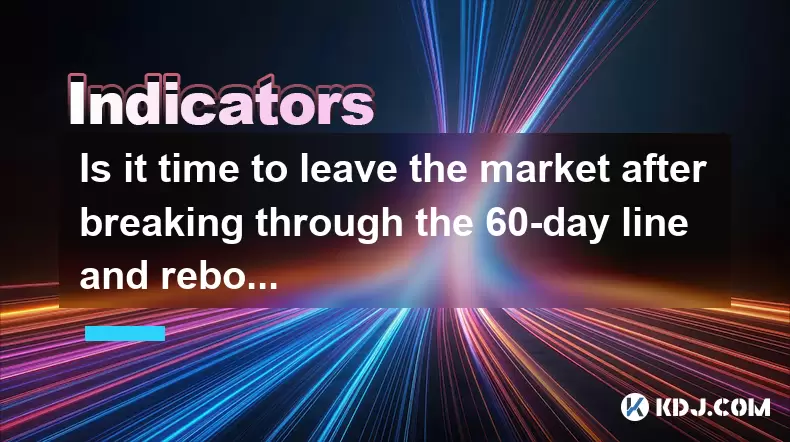
Understanding the 60-Day Moving Average in Cryptocurrency
In cryptocurrency trading, technical indicators play a pivotal role in decision-making. Among these, the 60-day moving average is widely used by both novice and experienced traders. This indicator calculates the average price of an asset over the last 60 days and helps identify long-term trends. When the price breaks above this line after a period of decline, it can signal a potential reversal.
A breakthrough of the 60-day moving average may suggest that bulls are gaining control. However, this alone doesn’t confirm a trend reversal. It’s crucial to analyze other factors such as volume, momentum oscillators, and broader market sentiment before making any conclusions about market direction.
What Does a Rebound After Breaking the 60-Day Line Mean?
When a cryptocurrency rebounds after breaking through its 60-day moving average, it often indicates a shift in market psychology. A rebound could mean that institutional or retail investors see value at current levels and are stepping in to buy. This kind of support can lead to short-term gains and renewed optimism.
However, not all rebounds are equal. A rebound with high trading volume typically carries more weight than one with low volume. Additionally, if the price closes consistently above the 60-day line for multiple days, it reinforces the strength of the breakout. Traders should also check for confluence with other indicators like RSI or MACD to assess whether the rally has sustainable momentum.
Why Some Traders Consider Exiting After a Breakout
Despite a positive move above the 60-day moving average, some traders choose to exit their positions. One reason could be profit-taking after a strong upward move. If the asset surged significantly from recent lows, locking in gains might be prudent, especially if resistance levels are nearby.
Another consideration is the possibility of a false breakout. Markets often experience fakeouts where prices briefly breach key levels only to reverse shortly afterward. Traders who got in early during a downtrend might view the 60-day line as a logical exit point rather than holding for further gains that may not materialize.
How to Assess Market Conditions Before Deciding to Exit
Before deciding to leave the market after a rebound from the 60-day line, traders should evaluate several elements:
- Volume confirmation: Was the breakout accompanied by increased volume?
- Candlestick patterns: Are there bullish continuation signals or signs of exhaustion?
- Market correlation: Is the broader crypto market trending up or down?
- On-chain metrics: Are large holders accumulating or distributing?
For instance, if Bitcoin breaks above its 60-day moving average but Ethereum remains below its key level, it may indicate divergent strength. Similarly, on-chain data showing whale accumulation could provide confidence that the trend is real.
Steps to Evaluate Whether to Stay or Leave the Market
To make an informed decision about exiting after a rebound, follow these steps:
- Review your entry point: Determine how much gain you've achieved since entering the trade.
- Check historical volatility: High volatility may justify taking partial profits.
- Identify upcoming resistance levels: If the price is approaching a known resistance, consider reducing exposure.
- Set stop-loss and take-profit levels: These help manage risk and secure profits automatically.
- Monitor macroeconomic events: News related to regulation or monetary policy can impact decisions.
Traders should avoid emotional decisions and rely on objective criteria. For example, if a trader entered at $25,000 and the price reaches $30,000 near a critical resistance zone, scaling out of the position makes sense even if the overall trend appears bullish.
Common Misconceptions About the 60-Day Line Breakout
Many traders believe that a simple break above the 60-day moving average guarantees a bullish trend. In reality, this level acts more as a reference point than a definitive signal. Some traders treat it as a dynamic support/resistance level, while others combine it with other tools like Fibonacci retracements or Bollinger Bands.
Another misconception is that exiting immediately after a rebound ensures safety. In fact, markets can continue rising beyond expectations, and premature exits may result in missed opportunities. Understanding the context of the breakout—such as whether it's part of a larger bull run or a temporary bounce—is essential.
Frequently Asked Questions
Q: Should I sell my entire position if the price breaks above the 60-day line?
Not necessarily. The decision depends on your strategy, risk tolerance, and the strength of the breakout. Many traders prefer to take partial profits while keeping the rest for potential further gains.
Q: How do I know if the rebound is genuine or just a false move?
Look for confirmation through volume, candlestick patterns, and secondary indicators like RSI or MACD. A sustained close above the 60-day line with increasing volume increases the likelihood of a real breakout.
Q: Can I re-enter the market after exiting post-breakout?
Yes, many traders use pullbacks to re-enter after confirming the trend remains intact. Watch for healthy retracements near the 60-day line or other key supports.
Q: What if the price fails to hold above the 60-day line after breaking through?
This could indicate weakness in the rally. Consider tightening stops or re-evaluating your position size. A failed breakout may lead to a resumption of the prior trend.
Disclaimer:info@kdj.com
The information provided is not trading advice. kdj.com does not assume any responsibility for any investments made based on the information provided in this article. Cryptocurrencies are highly volatile and it is highly recommended that you invest with caution after thorough research!
If you believe that the content used on this website infringes your copyright, please contact us immediately (info@kdj.com) and we will delete it promptly.
- Dogecoin to $1? Analysts Weigh In on DOGE's Breakout Potential
- 2025-06-27 10:30:12
- Memecoins, Growth, and Analysts: Decoding the Latest Trends
- 2025-06-27 10:30:12
- Arbitrum (ARB) Price Forecast 2025: Bullish Breakout or Sideways Shuffle?
- 2025-06-27 11:10:15
- Dogecoin, Meme Coins, and the Rise of Neo Pepe: What's Hot in Crypto?
- 2025-06-27 10:50:12
- Arctic Pablo Coin: The Meme Coin Primed for a 2025 Takeover?
- 2025-06-27 11:10:15
- Trump-Backed Stablecoin USD1: Audit Incoming, Aqua 1 Invests $100M in WLFI
- 2025-06-27 11:15:12
Related knowledge

How lethal is the death cross of EXPMA12 and 50 lines?
Jun 27,2025 at 11:15am
Understanding the Death Cross in EXPMA IndicatorsThe death cross is a technical analysis pattern that signals a potential bearish trend reversal. In the context of the EXPMA (Exponential Moving Average), particularly when analyzing the crossover between the EXPMA12 and EXPMA50 lines, traders often interpret this as a strong sell signal. The death cross ...
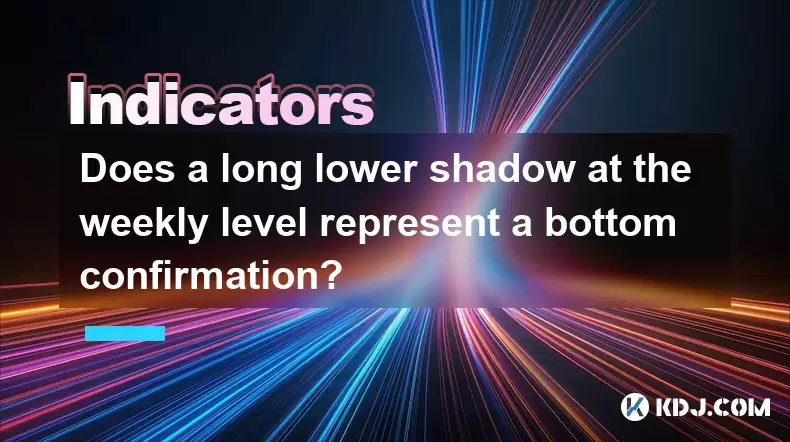
Does a long lower shadow at the weekly level represent a bottom confirmation?
Jun 27,2025 at 10:56am
Understanding the Weekly Lower Shadow in Candlestick AnalysisIn cryptocurrency trading, weekly candlestick patterns are often scrutinized for potential trend reversals. A long lower shadow at the weekly level indicates that during the week, sellers pushed prices down significantly but were met with strong buying pressure that closed the candle near its ...
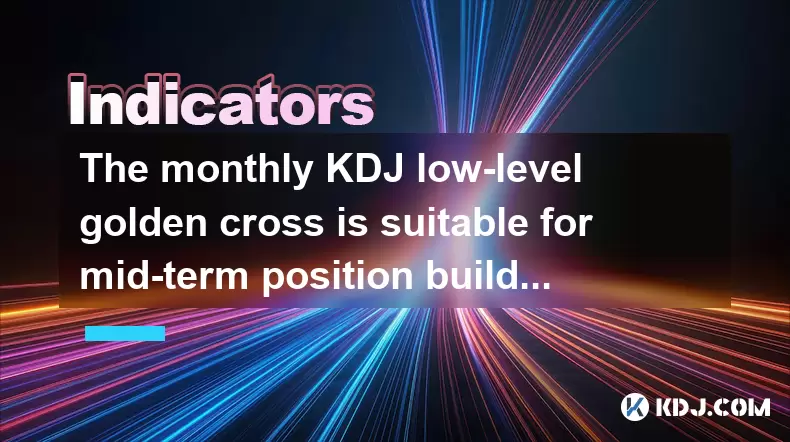
The monthly KDJ low-level golden cross is suitable for mid-term position building?
Jun 27,2025 at 03:14am
Understanding the Monthly KDJ IndicatorThe KDJ indicator, also known as the stochastic oscillator, is a momentum tool widely used in technical analysis within the cryptocurrency market. It consists of three lines: the K line, the D line, and the J line. These lines help traders identify overbought or oversold conditions, potential trend reversals, and e...
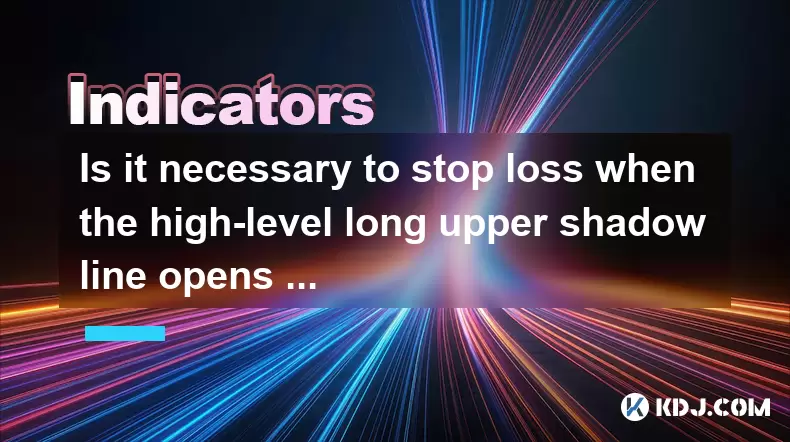
Is it necessary to stop loss when the high-level long upper shadow line opens low the next day?
Jun 27,2025 at 08:22am
Understanding the High-Level Long Upper Shadow LineIn technical analysis, a long upper shadow line refers to a candlestick pattern where the price moves significantly higher during the session but closes much lower, forming a long wick on the top. When this occurs at a high level, it suggests strong resistance and potential reversal. This type of candle...
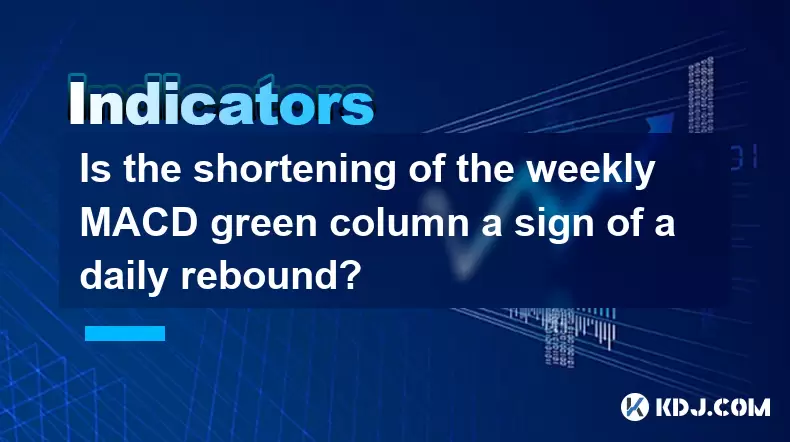
Is the shortening of the weekly MACD green column a sign of a daily rebound?
Jun 27,2025 at 10:22am
Understanding the Weekly MACD Green ColumnThe Moving Average Convergence Divergence (MACD) is a popular technical indicator used by traders to identify potential trend reversals and momentum shifts in financial markets, including cryptocurrencies. The green column in the MACD histogram represents the positive difference between the MACD line and the sig...

How sustainable is the rebound of the lower track of the Bollinger band?
Jun 27,2025 at 10:01am
Understanding the Bollinger Band and Its Lower TrackThe Bollinger Band is a widely used technical analysis tool in cryptocurrency trading, composed of a moving average (usually 20 periods) and two standard deviation lines plotted above and below it. The lower track, or lower Bollinger Band, represents a level that is typically two standard deviations be...

How lethal is the death cross of EXPMA12 and 50 lines?
Jun 27,2025 at 11:15am
Understanding the Death Cross in EXPMA IndicatorsThe death cross is a technical analysis pattern that signals a potential bearish trend reversal. In the context of the EXPMA (Exponential Moving Average), particularly when analyzing the crossover between the EXPMA12 and EXPMA50 lines, traders often interpret this as a strong sell signal. The death cross ...

Does a long lower shadow at the weekly level represent a bottom confirmation?
Jun 27,2025 at 10:56am
Understanding the Weekly Lower Shadow in Candlestick AnalysisIn cryptocurrency trading, weekly candlestick patterns are often scrutinized for potential trend reversals. A long lower shadow at the weekly level indicates that during the week, sellers pushed prices down significantly but were met with strong buying pressure that closed the candle near its ...

The monthly KDJ low-level golden cross is suitable for mid-term position building?
Jun 27,2025 at 03:14am
Understanding the Monthly KDJ IndicatorThe KDJ indicator, also known as the stochastic oscillator, is a momentum tool widely used in technical analysis within the cryptocurrency market. It consists of three lines: the K line, the D line, and the J line. These lines help traders identify overbought or oversold conditions, potential trend reversals, and e...

Is it necessary to stop loss when the high-level long upper shadow line opens low the next day?
Jun 27,2025 at 08:22am
Understanding the High-Level Long Upper Shadow LineIn technical analysis, a long upper shadow line refers to a candlestick pattern where the price moves significantly higher during the session but closes much lower, forming a long wick on the top. When this occurs at a high level, it suggests strong resistance and potential reversal. This type of candle...

Is the shortening of the weekly MACD green column a sign of a daily rebound?
Jun 27,2025 at 10:22am
Understanding the Weekly MACD Green ColumnThe Moving Average Convergence Divergence (MACD) is a popular technical indicator used by traders to identify potential trend reversals and momentum shifts in financial markets, including cryptocurrencies. The green column in the MACD histogram represents the positive difference between the MACD line and the sig...

How sustainable is the rebound of the lower track of the Bollinger band?
Jun 27,2025 at 10:01am
Understanding the Bollinger Band and Its Lower TrackThe Bollinger Band is a widely used technical analysis tool in cryptocurrency trading, composed of a moving average (usually 20 periods) and two standard deviation lines plotted above and below it. The lower track, or lower Bollinger Band, represents a level that is typically two standard deviations be...
See all articles
























































































